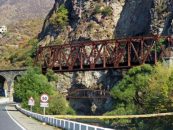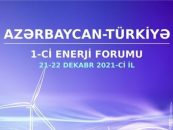An interview with Al Cook, BP Vice-President for Shah Deniz Development
A.T.: Early this year the media first heard the full story of Shah Deniz Full Field Development and we would like to build our interview on this story, but first let’s see what is Shah Deniz itself and why everyone in Europe is talking about Shah Deniz?
The Shah Deniz field is one of the world’s biggest gas-condensate fields, and the Shah Deniz Full Field Development (FFD) project is the largest project in the worldwide portfolio of BP – the operator of the project.
The field was first discovered in the Azerbaijan sector of the Caspian Sea in 1999. We believe it has over 30 trillion cubic feet – 1 trillion cubic metres – of gas in place.
Giant fields like Shah Deniz are often developed in stages and this is no exception. Despite the complexities of drilling the wells, building a platform, constructing an onshore terminal and laying a 700 km pipeline to Turkey, Shah Deniz Stage 1 was brought into production in just only seven years – a great achievement.
Since 2006 when we delivered First Gas, the field has proved to be a secure and reliable supplier of gas to the three countries. We have currently Stage 1 operational producing up some 800-850 million standard cubic feet per day (scfd) and exporting this production to Azerbaijan, Georgia and Turkey. The maximum rate of production from Stage 1 is expected to be 8.6 billion cubic meters of gas per annum (bcma) and about 45,000 barrels a day of condensate.
We are planning to increase the field’s production by three times through Shah Deniz FFD turning Azerbaijan into one of Europe’s major gas suppliers in just 6-7 years’ time.
A.T.: What exactly is Shah Deniz FFD about?
Shah Deniz FFD in itself is a giant project which is expected to add a further 16 bcma of gas production to the existing 8 bcma from Stage 1, tripling overall production from the field and opening up Azerbaijan as a major gas supplier to new gas markets. It is currently one of the largest gas development projects in the world. The project is designed to bring increased supply and diversity to the European gas markets through a new Southern Corridor – providing energy security to Turkey and Europe.
A.T.: So how do you intend to make this huge project live?
The Shah Deniz FFD concept includes two new bridge-linked production platforms with 16bcma offshore processing capacity, up to 30 subsea wells to be drilled with 2 semi-submersible rigs, 500 km of subsea pipeline network in up to 550m water depth, expansion of the Sangachal Terminal with compressors for Shah Deniz and the South Caucasus Pipeline (SCP), expansion of the SCP to Turkey through a new 400 km line in Azerbaijan and two new compression stations in Georgia, planned gas sales to Turkey, Georgia and Europe. At this stage the project plans to deliver First Gas in early 2017.
Engineering studies have continued during the first three quarters of 2010 to advance the Shah Deniz FFD and associated South Caucasus pipeline expansion projects. These works will continue throughout 2010 into 2011.
A.T.: What are the benefits of Shah Deniz FFD for Azerbaijan?
Well firstly, the project is expected to bring additional $20 bn investment to Azerbaijan and as a result the increased gas production will ensure Azerbaijan’s recognition as a major regional gas supplier adding to the country’s oil and gas revenues and making it a source of reliable and diversified gas supplies to Turkey and new European gas markets.
Secondly, Azerbaijan will gain new onshore assets, offshore facilities and expanded export infrastructure – all built to international standards using the most advanced industry technology.
Thirdly, most of the workforce who will build these facilities and infrastructure will be Azerbaijani nationals as we intend to do all construction and fabrication activities in the country -up to 10,000 local jobs are expected to appear through the development of Shah Deniz. We will ensure that contractor companies use a high percentage of Azerbaijani personnel in their activities and are committed to on-going training of national staff to further increase this proportion.
Shah Deniz FFD can establish Azerbaijan as a major provider of gas to Europe. By opening up the Southern Corridor, Azerbaijan will continue to build its growing reputation as an important provider of energy security.
A.T.: So my next question is about Europe – why is Shah Deniz gas important for Europe?
Energy security – the provision of energy that is available, affordable, secure and sustainable – is one of the biggest challenges that Europe faces in the 21st century.
In BP, we believe that natural gas will play an increasingly important role in helping Europe to meet this challenge. Why do we believe this? Firstly, gas is easily the cleanest burning fossil fuel, with CO2 emissions in power generation around 50% of those from coal. It’s also very efficient – its conversion efficiencies are about 35% better than coal. In addition, combined-cycle turbines, fuelled by natural gas, are quick and relatively cheap to build.
Shah Deniz gas is important because it can bring gas supply from a new region to Europe. This supports the aims of the European Commission in providing greater energy security, supply diversity and market liquidity. But Shah Deniz gas is even more important because it opens up the Southern Corridor for gas to Europe. It paves the way for future supplies from Azerbaijan and other countries, by demonstrating that the Southern Corridor is commercially viable.
A.T.: The Azerbaijan government recently agreed a Memorandum of Understanding (MoU) with the Government of Turkey. What is the impact of this agreement on your plans?
We in BP welcomed the agreement as it naturally enhanced the project progress. The MOU which was signed in Istanbul in June 2010 is part of a package of documents that shall regulate the sale of Azerbaijani gas to Turkey and transit terms for transportation of the gas to the European markets through the territory of Turkey. We believe this marked a major step forward towards conclusion of required agreements for Shah Deniz FFD gas sales to Turkey and beyond and is a milestone that underpins the significance of the Shah Deniz FFD plans and paves the way for the project to move forward towards a final investment decision.
A.T.: How much gas will Shah Deniz FFD deliver to Europe?
We were positively surprised by the high level of demand for Azerbaijani gas in Europe and discussions are currently underway with all interested parties to agree all necessary steps.
A.T.: How are you going to get Shah Deniz gas to Europe?
A.C.: It is planned that the project itself will take Shah Deniz FFD gas to the Turkish border. In order to transport the gas to Turkish and European markets, the project will need further new pipelines. At this stage discussions are underway to define the route which best meets the needs of all parties involved – and which will with Turkey establish a new Southern Corridor for gas supply to Europe. These negotiations are led by SOCAR and the Azerbaijan Government, with the involvement of BP and other Shah Deniz partners.
A.T.: What is the timeframe for Shah Deniz FFD?
The project has completed concept optimization and moved to the detailed engineering for the upstream project, terminal and pipeline. This engineering is enabling us to refine cost estimates and project plans to support a decision to progress the project into the next step – front end engineering design during 2011. This work has all progressed well and we are confident we can deliver first gas in 2017






